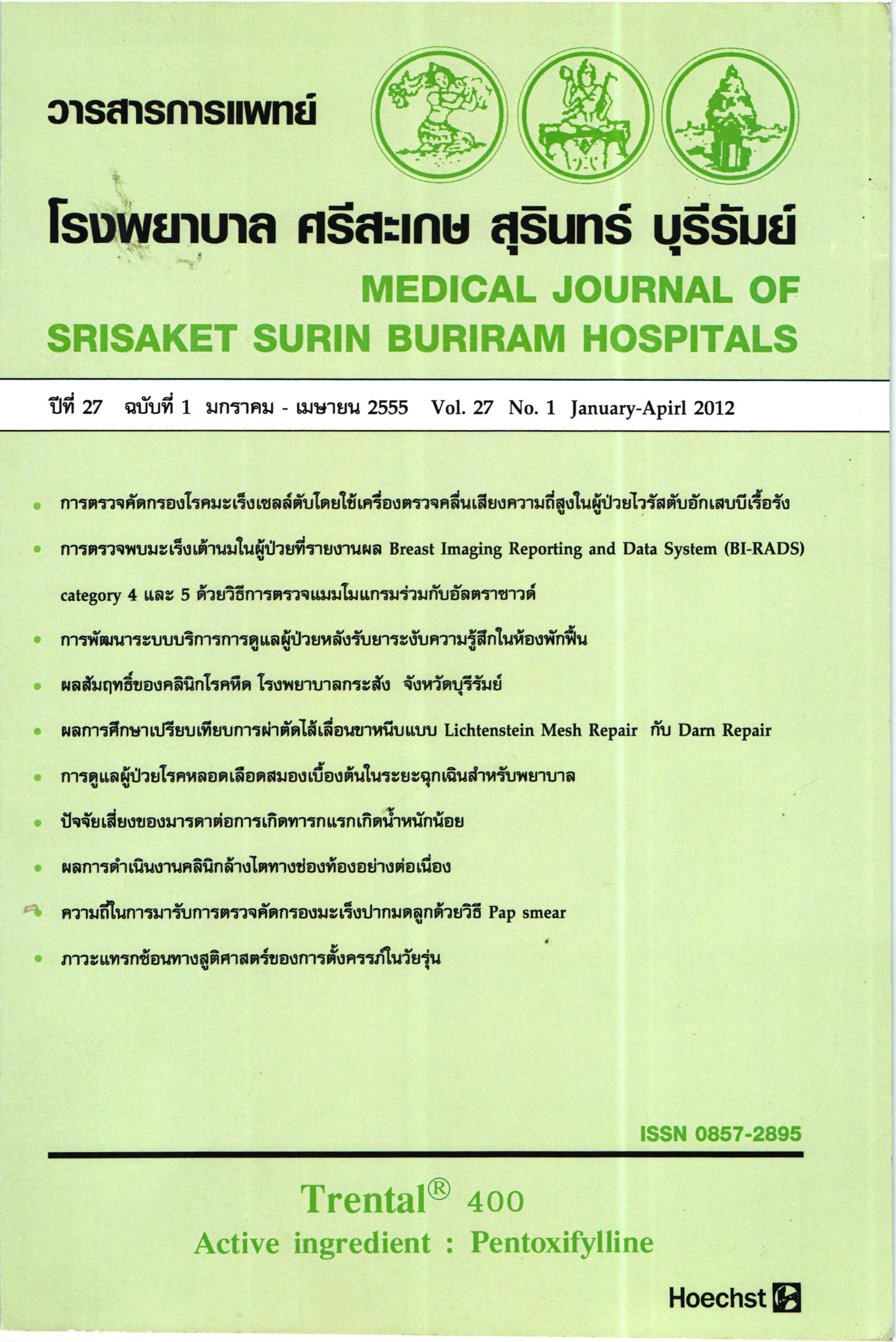ความถีในการมารับการตรวจคัดกรองมะเร็งปากมดลูกด้วยวิธี Pap smear
Main Article Content
บทคัดย่อ
วัตถุประสงค์: เพื่อศึกษาความถี่ในการมารับการตรวจคัดกรองมะเร็งปากมดลูกด้วยวิธี Pap smear รูปแบบการวิจัย: การวิจัยเซิงพรรณนา
วิธีการศึกษา: ศึกษาโดยใช้แบบสอบถามสัมภาษณ์สตรีที่มารับบริการตรวจคัดกรองมะเร็งปาก มดลูกที่สถานี อนามัย ในเขตอำเภอเมืองและอำเภอภูเพียง จ.น่านระหว่างวันที่ 1 พฤษภาคม ถึงวันที่ 30 มิถุนายน 2554 เพื่อสอบถามความถี่ในการมารับการตรวจ มะเร็งปากมดลูกด้วยวิธี Pap smear
ผลการศึกษา: สตรีจำนวน 811 คน ร้อยละ 93.2 เคยได้รับการตรวจคัดกรองมะเร็งปากมดลูกโดยวิธี Pap smear อย่างน้อยหนึ่งครั้ง ร้อยละ 55.7 ตรวจคัดกรองมะเร็งปากมดลูกอย่างน้อย ปีละหนึ่งครั้ง ร้อยละ 27 ตรวจคัดกรอง 2-3 ครั้งภายในระยะเวลา 5 ปีที่ผ่านมา มีเพียง ร้อยละ 14.2 ที่ตรวจคัดกรองมะเร็งปากมดลูก 1 ครั้งภายในระยะเวลา 5 ปีที่ผ่านมา ผู้ที่ ตรวจมะเร็งปากมดลูกอย่างน้อยปีละครั้งมีแนวโน้มที่จะไม่หยุดตรวจคัดกรองมะเร็ง ปากมดลูกมากกว่าผู้ที่เว้นช่วงในการตรวจคัดกรองนานกว่า (6.2% [26/421] vs. 12.2% [41/335]) ร้อยละ 23 ของผู้รับบริการเชื่อว่าการตรวจคัดกรองมะเร็งปากมดลูกทุก 5 ปี ตามนโยบายสามารถป้องการเกิดมะเร็งปากมดลูกได้ สาเหตุที่สตรีไม,ตรวจคัดกรองมะเร็ง ปากมดลูกตามนโยบายเพราะคิดว่าช่วงเวลาที่จะมารับการตรวจซ้ำนานเกินไป การตรวจทุกปี เป็นผลดีต่อสุขภาพ และวิตกกังวลว่าจะเป็นมะเร็งปากมดลูก
สรุป: สตรีในในเขตอำเภอเมืองและอำเภอภูเพียง จังหวัดน่านมีความถี่ในการตรวจคัดกรองมะเร็ง
ปากมดลูกมากกว่าที่นโยบายกำหนด การจัดระบบคัดกรองที่ดี การให้คำแนะนำและขี้แจง เหตุผลในการตรวจคัดกรองมะเร็งปากมดลูกน่าจะช่วยป้องกันการเกิดมะเร็งปากมดลูกในระยะเริ่มต้นได้
Article Details
เอกสารอ้างอิง
2. Saslow D, Runowicz CD, Solomon D, et al. American Cancer Society Guideline for the Early Detection of Cervical Neoplasia and Cancer. CA Cancer J Clin 2002; 52;342-62.
3. Cervical cytology screening. AGOC Practice Bulletin No. 109. American College of Obstetricians and Gynecologists.ObstetGynecol 2009;114: 1409-20.
4. International agency for Research on Cancer, World Health Organization. IARC Handbooks of Cancer Prevention Vol.10. Cervix Cancer Screening. France: IARC Press; 2005.
5. Sirovich, B., Welch, H. The frequency of Pap smear screening in the United States.J Gen Intern Med. 2004; 19:243-50.
6. Cervical cytology screening. AGOC Practice Bulletin No.109.American College of Obstetricians and Gynecologists.ObstetGynecol 2009; 109: 1-12.
7. Sasieni P, Adams J, Cuzick J, Benefit of cervical screening at different ages: evidence from the UK audit of screening histories. Br J Cancer 2003; 89: 88-93.
8. Miles A, Cockburn J, Smith RA, Wardle J A perspective from countries using organized screening programs. Cancer. 2004;101(Suppl 5):1201-13.
9. Chumnan K. Cervical Cancer Screening: Situation in Thailand and Literature Re view. Srinagarind Med J 2006; 21(3): 249-55.
10. Shaw M, Galobardes B, Lawlor DA, Lynch JW, Smith GW. The Handbook of Inequality and Socioeconomic Position: Concepts and Measures. Bristol, UK: The Policy Press, 2007.
11. Palencia L, Espelt A, Rodriguez-Sanz M et al. Socioeconomic inequalities in breast and cervical cancer screening practices in Europe: influence of the type of screening program. Int J Epidemiol 2010; doi:10.1093.ije/dyq003 [Epub 22 February 2010].
12. Taylor V, Yasui Y, Burke N, Nguyen T, Acorda E, Thai H, et al. Pap testing adherence among Vietnamese American women. Cancer Epidemiol Biomarkers prev 2004; 13(4):613-9.
13. Coughlin SS, Breslau ES, Thompson T, Benard VB. Physician recommendation for Papanicolaou testing among US. women, 2000. Cancer Epidemiol Biomarkers 2005; 14(5): 1143-8.
14. Insinga R., Glass A., Rush B., Pap screening in a U.S. health plan. Cancer Epidemiol Biomarkers Prev 2004;13(3):355-60.


